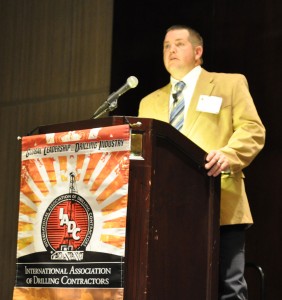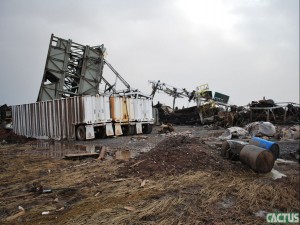12 lives saved in F5 tornado proves value of Cactus Drilling emergency plan
By Katherine Scott, editorial coordinator

In the drilling business, there’s nothing like being prepared. Kenny Baker, drilling superintendent for Cactus Drilling Company, witnessed firsthand the value in having an emergency preparedness plan last year. Through a personal story told at the IADC Health, Safety, Environment and Training Conference and Exhibition on 7 February in Houston, Mr Baker showed how an emergency preparedness plan – implemented after initial doubts and resistance – saved 12 lives during an F5 tornado in Oklahoma in 2011.
Creating the plan started by recognizing opportunities where an emergency could affect the company’s crews, then extended into a search for ways to implement procedures and make changes to the work environment in order to protect employees.
Cactus Drilling has nearly 40 rigs operating in Oklahoma, a state that suffers an average of 52 tornadoes a year. In 2007, a tornado in the state blew away a trailer house, killing a company man and injuring another employee. Although neither worked for Cactus, the event gave Kathy Willingham, vice president of human resources and HSE for Cactus Drilling, the idea to prepare her company for tornado emergencies. She asked, “Why not anchor the change house?”
After first meeting resistance and doubts, Ms Willingham convinced the company to implement the plan. At a cost of approximately $500,000, Cactus anchored its rig change houses to withstand an F5 tornado. On 24 May 2011, Cactus Rig 117, operating near Calumet, Okla., suffered a direct hit by an F5 tornado that resulted in an estimated $14 million in damage.

Not a single life was lost.
“It’s the whole principle. Stop the job; stand up for what you believe in. You have to be persistent. Set out an expectation (for your workers), and they’ve got to follow that expectation or you’re not going to be a good leader,” Mr Baker said, “It’s not what about what somebody can do for you. It’s what you can do for somebody else.”
The anchoring process for the change house can add roughly two hours to rig moves. Further, considering that the average cost to anchor the change house was $1,500 and the average price for the welding work was $2,500, the total cost added up to approximately half a million dollars for Cactus. However, no one at the company would argue that the plan wasn’t a worthwhile investment when it ultimately saved lives.
“Twelve men walked into that change house, and twelve men walked out,” Mr Baker said. “I’m going to encourage everybody that’s got the authority to go out on a limb … and try to make some kind of emergency plan. Get something out there for (your crew). … Come up with an idea, because (an emergency) will happen and you can’t say (your plan) won’t work.”





My Dad and Husband were 2 of the 12 men on that rig that day. I am very thankful they are still alive and with us 🙂
I am looking for more in formation on the tie down equipment and procedure. I have approximately 400 employees in the field and we are looking for tornado shelter information.
Great job protecting your people.
Robert Stoll, Safety Engineer
Flat Ridge II Wind Project
770-714-9407